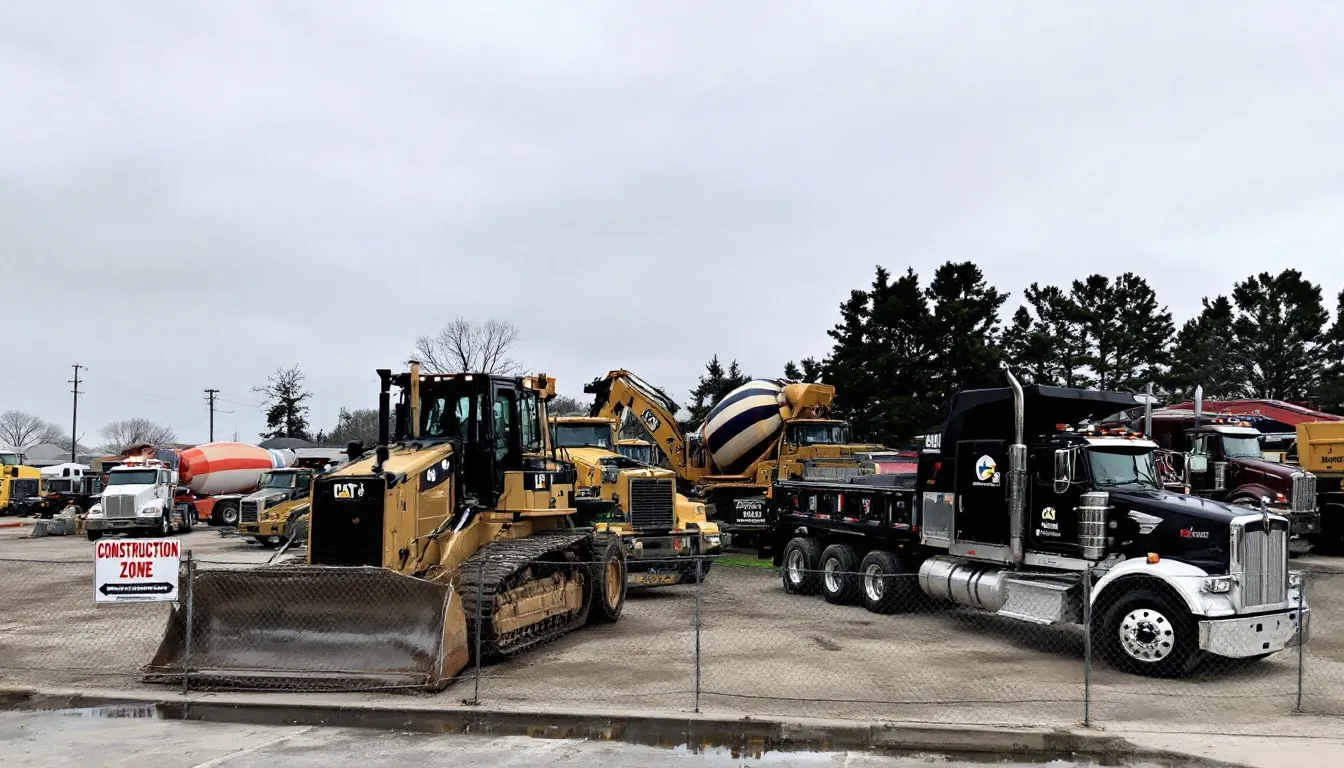What is the Section 179 Tax Savings Deduction?
The Section 179 tax deduction is a powerful tax benefit designed to help businesses immediately deduct the full purchase price of qualifying equipment and vehicles from their taxable income. By allowing you to write off the entire cost of eligible vehicles in the same tax year they are placed in service, Section 179 can provide significant tax savings and boost your business’s cash flow. This immediate tax benefit is available for many vehicles, including cars, trucks, vans, and SUVs, provided they are used for business purposes. If a vehicle is financed, the entire purchase price can still be claimed as a deduction in the year it is purchased.
To qualify for the Section 179 deduction, vehicles must generally have a gross vehicle weight rating (GVWR) of over 6,000 pounds, though certain passenger vehicles may also be eligible under specific limits. The Internal Revenue Service (IRS) sets the maximum deduction limit each year and the phase-out threshold for total equipment purchases. By leveraging the Section 179 tax deduction, businesses can reduce their taxable income, lower their tax liability, and reinvest those savings into business growth. Whether making major purchases or upgrading your fleet, Section 179 can help you immediately deduct the full purchase price of qualifying equipment and vehicles, maximizing your tax savings.
Can You Take Section 179 Deductions on Vehicles?
For the 2025 tax year, the maximum Section 179 deduction limit is $1,250,000.
Are you considering purchasing or financing a new or used vehicle for your small business? Maybe you’ve already bought a new vehicle this year. If this is the case, you may qualify for a tax benefit. The Section 179 tax deduction is a great way to save you some money.
That’s because it lets you deduct all or part of the vehicle cost in the first year it’s purchased and placed in use, as long as your vehicle qualifies. The Section 179 tax deduction allows eligible businesses to deduct the full cost of qualifying vehicles in the year they are placed into service. This deduction acts as a tax write-off, directly reducing your business’s taxable income.
When it comes to purchasing a vehicle, there are some questions you’re going to want answers to before making the purchase. It’s highly recommended that you consult a tax professional or an accountant to determine if the vehicle you’re looking to buy qualifies for a Section 179 vehicle deduction and, if so, what amount. A qualified professional can help verify vehicle eligibility, such as confirming the gross vehicle weight rating (GVWR), and ensure compliance with IRS requirements.
There are many ways to take advantage of the Section 179 Deduction. One popular way has been by buying vehicles for business purposes. You may have heard it called the “Hummer Deduction” or “SUV Tax Loophole” a few years ago because, at that time, you could write off a large SUV purchase with this tax deduction. Some luxury vehicles, including certain SUVs, may still qualify for Section 179 if they meet IRS criteria.
Since its inception, the Section 179 tax code has been modified with new deduction limits and rules. However, purchasing vehicles for business purposes can still be advantageous regarding tax benefits.
While most business-use vehicles qualify, certain passenger vehicles have a deduction cap of $12,200. However, other vehicles not likely to be used for personal reasons, such as certain vehicles over 6,000 pounds gross vehicle weight, qualify for the full deduction under Section 179, which is $28,900.
Which Business Vehicles Qualify for the Section 179 Deduction Tax Breaks?
The IRS always updates its guidance for Section 179 deductions, sometimes issuing new rules or clarifications about allowable expenditures and depreciation for company vehicles if they are also used personally. For tax purposes, the vehicle’s weight, specifically whether it meets or exceeds 6,000 lbs, is a key factor in determining eligibility for these deductions. Understanding these changes could affect your own business vehicle deductions as well!
In most cases, heavy SUVs, trucks, vans, and passenger vehicles are some of the most common business-related vehicles that qualify as eligible assets for the Section 179 tax deduction and bonus depreciation. Sport utility vehicles (SUVs) are included among these eligible assets, provided they meet the 6,000-lb weight threshold and are used at least 50% for work purposes. If these requirements are met, you can enjoy the tax benefits!
Below, we’ll discuss the types of vehicles that qualify for Section 179 deductions, and then further on in the guide, we’ll discuss any rules and considerations that we must consider.
Business Use Requirement for Section 179 Vehicles
To take advantage of the Section 179 deduction for vehicles, the vehicle must be used at least 50% of the time for business purposes. If you use your vehicle for business and personal reasons, only the portion used for business income is eligible for the deduction. For example, if you drive your vehicle 80% of the time for business and 20% for personal use, you can only claim a Section 179 deduction on 80% of the vehicle’s cost.
The IRS requires that you maintain detailed records to support your business use claim. This includes keeping mileage logs, receipts, and any documentation that shows how the vehicle is used for business purposes. Accurate recordkeeping is crucial in case of an audit and to ensure you receive the full tax benefit you’re entitled to. Remember, the Section 179 deduction is only available for vehicles that generate business income, not for personal use.
The Following Types of Vehicles Qualify for Section 179 Deductions:
The IRS categorizes eligible vehicles for Section 179 deductions based on their weight and intended use, including whether the vehicle is classified as a passenger vehicle.
Smaller Business Vehicles:
Smaller vehicles are used by millions of small businesses across the U.S. and can include:
- Vehicles below 6000 pounds can include passenger cars, crossover vehicles, SUVs, and small utility trucks.
- Vehicles with passenger seating of nine or more behind the driver’s seat, such as limousines and airport shuttle vans/transport vans.
- Vehicles with:
- A driver’s cabin/passenger area and rear compartment cargo area that is fully separated.- No passenger seating anywhere behind the driver’s seat.
- No part of the vehicle’s body section extends more than 30″ ahead of the windshield.
In most cases, the above bullets would describe a small cargo truck, pickup truck, or cargo van. In the first year they are put in service, small vehicles are allowed a $12,200 Section 179 deduction with a total of $20,200,100 using bonus depreciation.
It’s pretty common for small vehicles to be used for personal purposes part of the time. In this case, your deduction would be proportionally reduced based on the time the vehicle is used for business and personal activities. Car expenses, such as gas, insurance, and repairs, must also be allocated based on the business use proportion.
Heavy Business Vehicles:
Heavy vehicles are generally employed by larger businesses and can include:
- Vehicles that weigh at least 6,000 pounds and max out at 14,000 pounds.
- Can consist of SUVs, pickup trucks, and vans that weigh over 6,000 pounds.
- Forklifts, heavy construction equipment, tractor-trailers, and similar vehicles.
- Vehicles with load-carrying devices, such as those with enclosed cargo areas, may also qualify for Section 179 deductions.
What’s the GVWR? It stands for Gross Vehicle Weight Rating, and it’ll be listed on your vehicle’s manufacturer label, usually right next to make, model, features, and more.
The benefit of purchasing a heavy vehicle in 2023 is that the deduction limit for Section 179 has increased to $29,060, which is more than double what you can deduct for smaller vehicles. Suppose you buy a cargo truck for $50,000 and use it solely for your small business.
The purchase would qualify for the $29,060 dollar limit Section 179 deduction. It would also be able to deduct bonus depreciation for the first year of $14,530, which is 50% of the non-deductible portion of the purchase price of the cargo truck.
Your deductible on the $50,000 cargo truck would be $43,590 in the first year, resulting in a significant tax break. However, other rules could apply, so consult an accountant and/or a tax professional to confirm.
What Are the Section 179 Tax Deduction Write-Off Limits?
In 2023, the write-off dollar limits for smaller vehicles used for business purposes over 50% of the time, including the Section 179 deduction and bonus depreciation, are $11,300 for cars and $11,700 for vans and trucks.
The bonus depreciation rate, which determines the percentage of a qualifying vehicle’s cost that can be deducted in the first year, is 60% for 2024 and will decrease to 40% in 2025. This reduction in the bonus depreciation rate means a lower deductible amount for qualifying vehicles purchased in 2025 than in 2024.
If total equipment purchases exceed $3,130,000, the Section 179 deduction begins to phase out on a dollar-for-dollar basis. The deduction limit for SUVs under Section 179 for 2025 is $31,300.
Below are the exceptions to the above rule, and may qualify for a $28,900 deduction:
- Taxis, vans for transporting people or property, and other vehicles used primarily for transportation.
- Hearses, Ambulances, and Ambulettes that are exclusively used for your business.
- Vehicles that are not meant for personal use (those that have been extensively modified for business purposes)
- Other types of heavy vehicles and trucks with an area of at least six feet (people cannot easily access this area from the passenger space).
- Most vehicles with a gross vehicle weight rating higher than 6,000 pounds but less than or equal to 14,000 pounds are placed in service in the tax year purchased.
While Section 179 allows for a deduction, some vehicle purchases may also qualify for a tax credit, directly reducing the tax owed.
What Are Some Rules & Considerations for Section 179 Vehicle Deductions?
- The vehicle must be acquired and titled under the company name, not the name of any owner/shareholder of the company.
- The vehicle can be purchased outright, financed through loans, or leased, and it is considered an arms-length transaction. Lease payments may also be deductible based on the business use percentage.
- The vehicle must be new to you and can be either new or used.
- To qualify for the Section 179 deduction, the vehicle must be used for business at a minimum of 50% of the time you use it. You can only deduct the corresponding business use percentage if it is less than 100% for business purposes.
- Proof that you are using the vehicle for business purposes is mandatory, so make sure you can do so if the IRS audits you. Tracking business miles is essential for calculating the deductible expense.
- Businesses can only claim section 179 deductions for the tax year the business vehicle is placed in service.
- If you used a vehicle for personal purposes and then converted it into use for business purposes, it doesn’t qualify for the deduction in a later year.
- The Section 179 deduction can’t be greater than the net taxable income.
- The deduction on business vehicles is the same regardless of the purchase method, leased or financed with a qualified Section 179 Vehicle or Equipment Financing. When using the actual expenses method, you must track all costs, including gas, repairs, insurance, depreciation, and lease payments, and only the business-use portion is a deductible expense.
- Optimizing Section 179 deductions can help reduce your overall business taxes.
How do you calculate the Section 179 Vehicle Deduction?
When you know your business use percentage, calculating your Section 179 vehicle deduction is straightforward. Start by determining the percentage of the vehicle’s use for business purposes. To find the deductible amount, multiply this percentage by the vehicle’s purchase price. For instance, if you purchase a vehicle for $50,000 and use it 80% for business, your Section 179 deduction would be $40,000 (80% x $50,000).
Alternatively, you can use the actual expense method, which involves tracking all vehicle-related expenses, such as fuel, maintenance, insurance, and repairs, and multiplying the total by your business use percentage. This method can sometimes yield a larger deduction, especially if your vehicle expenses are high. Whichever method you choose, the Section 179 deduction allows you to reduce your taxable income by the qualifying amount, providing valuable tax savings for your business.
How do depreciation and the remaining cost after the Section 179 Deduction work?
After you’ve claimed the Section 179 deduction on your business vehicle, you may still have a portion of the cost that hasn’t been deducted. The IRS allows you to depreciate this remaining cost over time using the Modified Accelerated Cost Recovery System (MACRS). Under MACRS, the remaining cost of your vehicle can typically be depreciated over a five-year period, following a set depreciation schedule.
For example, if you purchase a vehicle for $50,000 and take a Section 179 deduction of $40,000, the remaining $10,000 can be depreciated over the next five years. This approach allows you to continue receiving tax benefits on your vehicle purchase beyond the initial year, reducing your taxable income and supporting your business’s financial health.
What are the benefits of Section 179 for Small Business Owners?
Section 179 offers a range of benefits for small business owners looking to maximize their tax savings and support business growth. By allowing you to deduct the full purchase price of qualifying equipment and vehicles in the year they are placed in service, Section 179 can significantly reduce your taxable income and lower your overall tax liability. This immediate tax benefit helps improve your business’s cash flow, making reinvesting in operations, hiring new staff, or purchasing additional qualifying equipment easier.
For many small business owners, the ability to write off major purchases in the same tax year provides a competitive edge and supports long-term business growth. Section 179 is especially valuable for small businesses looking to upgrade their vehicles or expand their fleet without straining their finances. To ensure you’re making the most of all available tax benefits, including the Section 179 deduction, it’s wise to consult a qualified tax professional to help you with tax planning and compliance. By leveraging Section 179, small businesses can enjoy immediate tax savings and position themselves for continued success.
IRS Guidelines for Section 179 Vehicles Are Ever-Changing
The business-use percentage must be applied to the vehicle’s purchase price to calculate the deductible amount. Understanding the difference between business and personal use is important before deciding where your Section 179 deduction falls.
When claiming Section 179 deductions, maintaining detailed documentation and records is crucial to substantiate your claims on your tax return. For instance, Instructions for Form 2106 explain business vs. personal use in detail.
They also provide instructions on depreciation deductions and amortization with Form 4562, which reports depreciation deductions, including those for vehicles. In addition to vehicles, office furniture is also eligible for immediate expensing under Section 179. As always, ask your tax professional for answers about the Section 179 deduction, particularly concerning vehicles, to determine your possible expense deduction and tax savings.












